NS5070P: Leadership Analysis of Staff Shortage at King Faisal
VerifiedAdded on 2023/04/25
|15
|4377
|184
Report
AI Summary
This paper examines the critical issue of staff shortages at the gynecology ward of King Faisal Hospital in Riyadh, Saudi Arabia, applying nursing leadership and management theories to analyze the impact and propose solutions. It highlights the challenges faced by nurse leaders due to inadequate staffing, including increased stress, longer working hours, and potential negative impacts on patient care quality and staff motivation. The report emphasizes the importance of staffing in healthcare settings, linking it to patient satisfaction, outcomes, and hospital financial performance. It discusses the need for improved recruitment and retention strategies, addressing issues like work-life balance and burnout. The analysis incorporates transformational leadership concepts and Maslow’s hierarchy of needs, advocating for a supportive work environment to improve job satisfaction and reduce turnover. The paper concludes by recommending strategies to restructure work hours, improve recruitment, and address quality issues, emphasizing the need for nurse managers to apply nursing leadership theory effectively to overcome staffing challenges and fulfill the hospital's vision of providing high-quality care. Desklib provides a platform to access this and many other solved assignments.
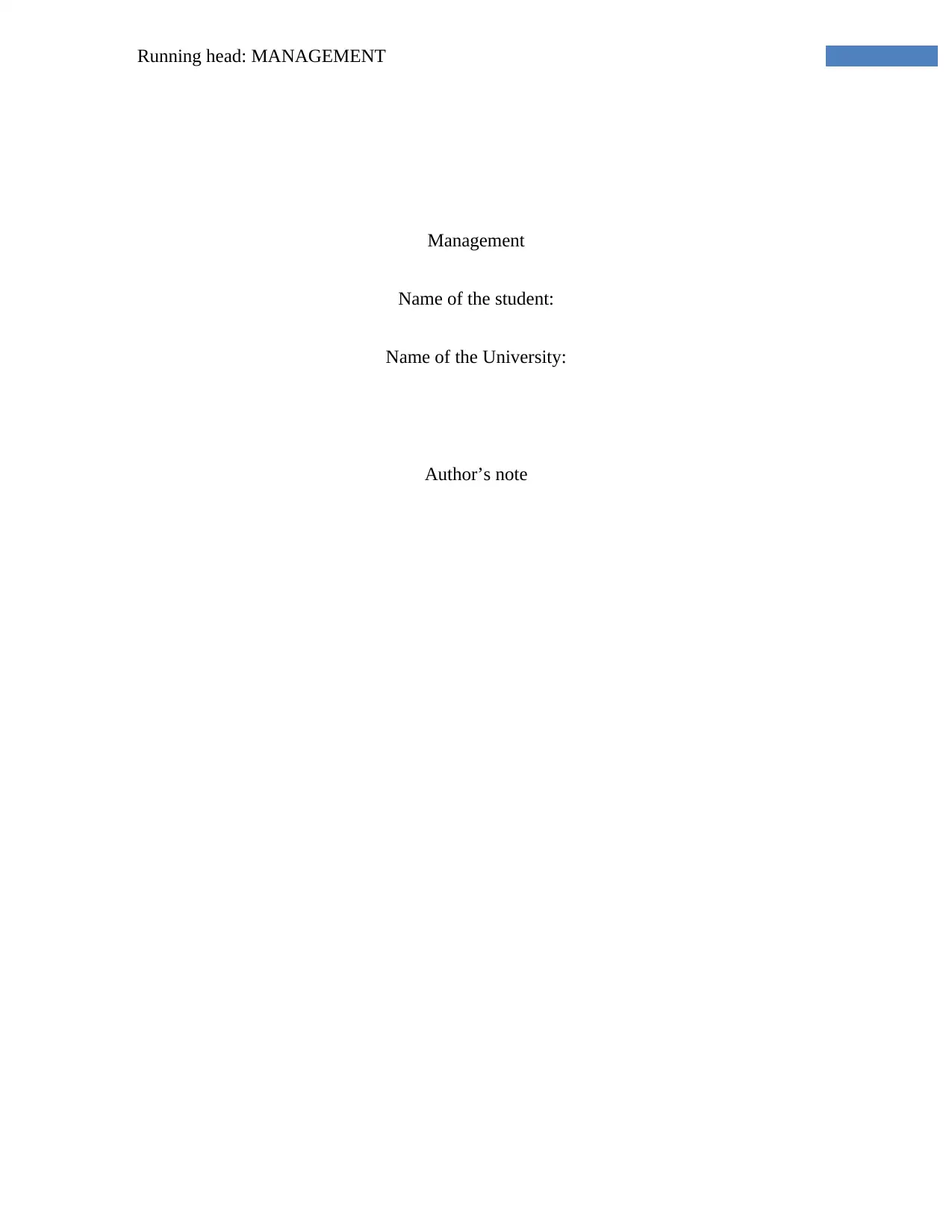
Running head: MANAGEMENT
Management
Name of the student:
Name of the University:
Author’s note
Management
Name of the student:
Name of the University:
Author’s note
Paraphrase This Document
Need a fresh take? Get an instant paraphrase of this document with our AI Paraphraser
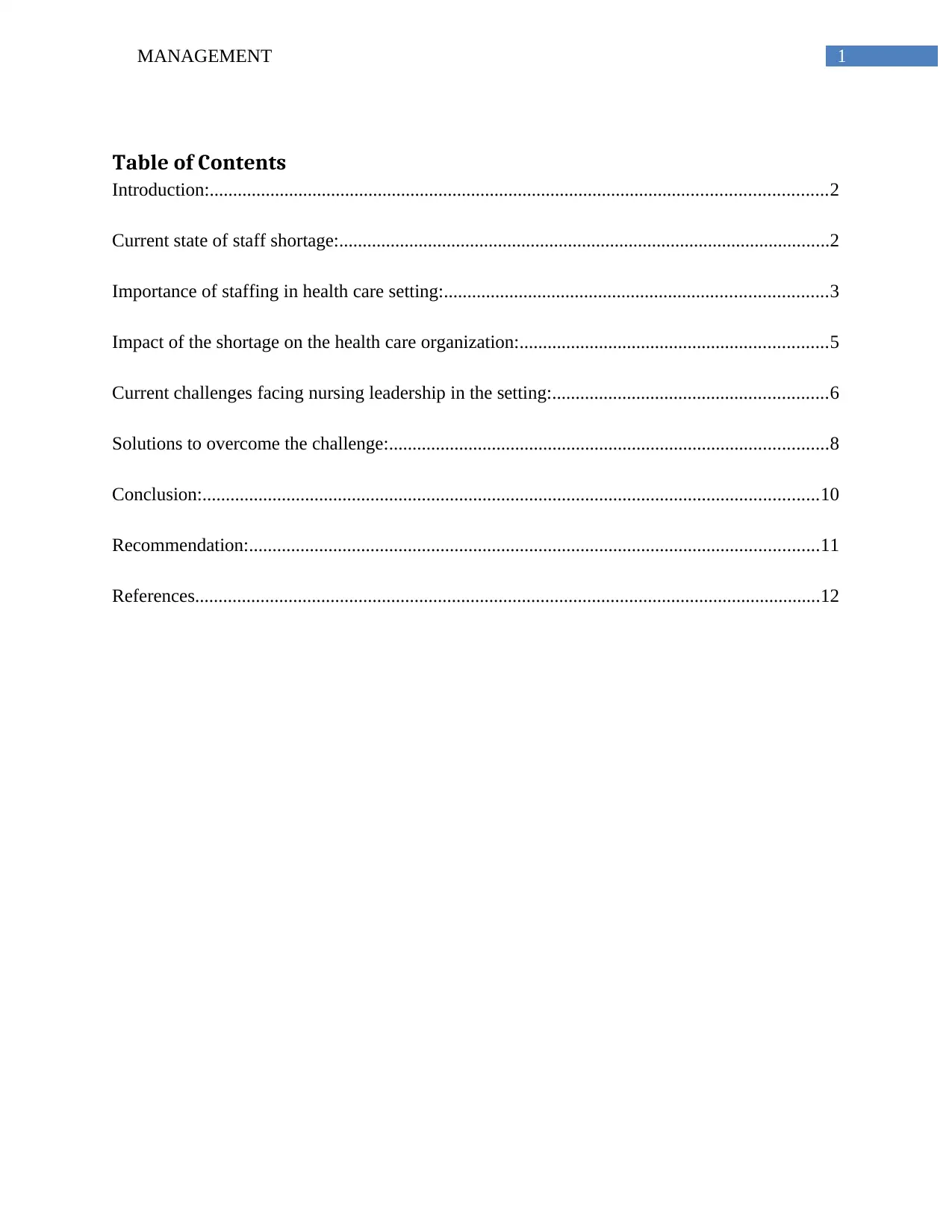
1MANAGEMENT
Table of Contents
Introduction:....................................................................................................................................2
Current state of staff shortage:.........................................................................................................2
Importance of staffing in health care setting:..................................................................................3
Impact of the shortage on the health care organization:..................................................................5
Current challenges facing nursing leadership in the setting:...........................................................6
Solutions to overcome the challenge:..............................................................................................8
Conclusion:....................................................................................................................................10
Recommendation:..........................................................................................................................11
References......................................................................................................................................12
Table of Contents
Introduction:....................................................................................................................................2
Current state of staff shortage:.........................................................................................................2
Importance of staffing in health care setting:..................................................................................3
Impact of the shortage on the health care organization:..................................................................5
Current challenges facing nursing leadership in the setting:...........................................................6
Solutions to overcome the challenge:..............................................................................................8
Conclusion:....................................................................................................................................10
Recommendation:..........................................................................................................................11
References......................................................................................................................................12
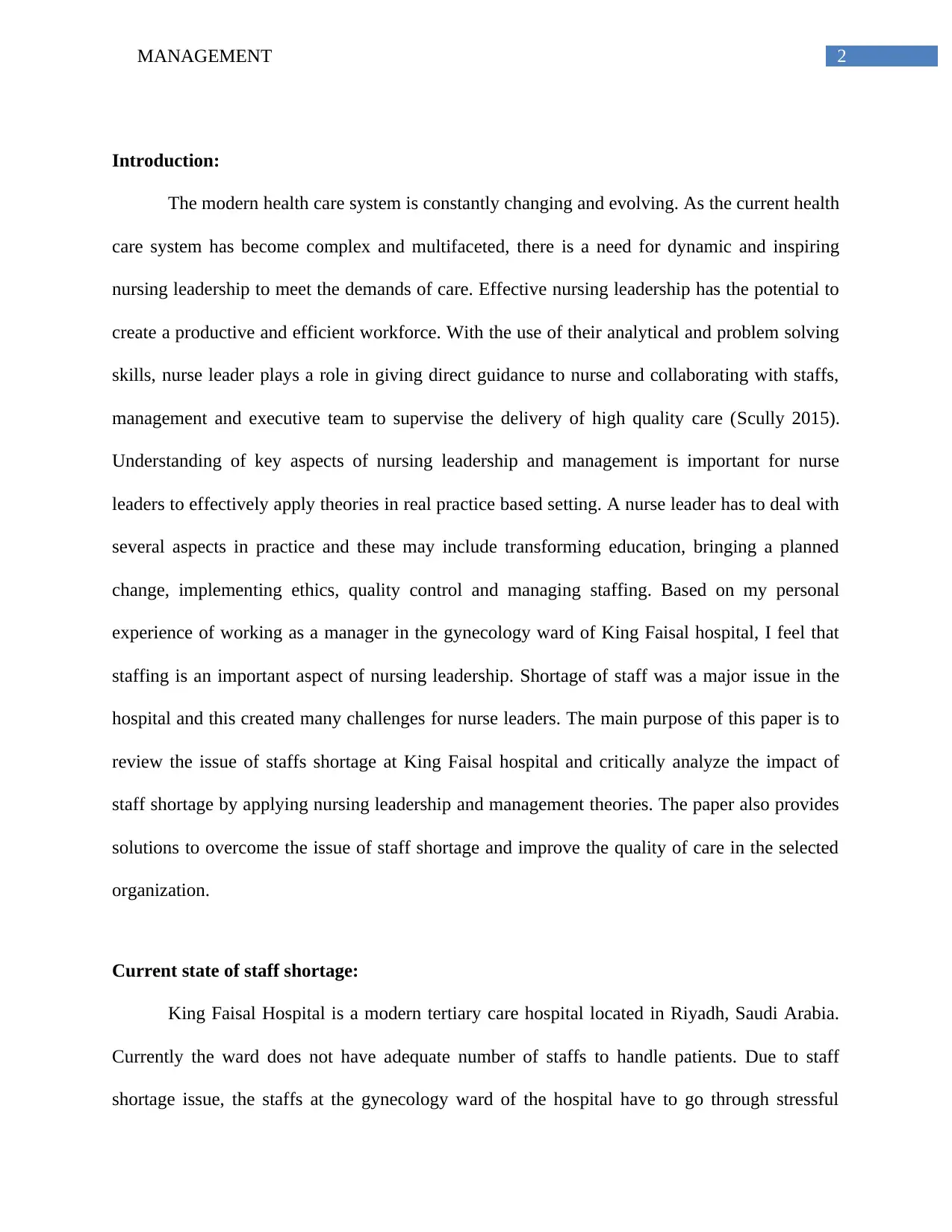
2MANAGEMENT
Introduction:
The modern health care system is constantly changing and evolving. As the current health
care system has become complex and multifaceted, there is a need for dynamic and inspiring
nursing leadership to meet the demands of care. Effective nursing leadership has the potential to
create a productive and efficient workforce. With the use of their analytical and problem solving
skills, nurse leader plays a role in giving direct guidance to nurse and collaborating with staffs,
management and executive team to supervise the delivery of high quality care (Scully 2015).
Understanding of key aspects of nursing leadership and management is important for nurse
leaders to effectively apply theories in real practice based setting. A nurse leader has to deal with
several aspects in practice and these may include transforming education, bringing a planned
change, implementing ethics, quality control and managing staffing. Based on my personal
experience of working as a manager in the gynecology ward of King Faisal hospital, I feel that
staffing is an important aspect of nursing leadership. Shortage of staff was a major issue in the
hospital and this created many challenges for nurse leaders. The main purpose of this paper is to
review the issue of staffs shortage at King Faisal hospital and critically analyze the impact of
staff shortage by applying nursing leadership and management theories. The paper also provides
solutions to overcome the issue of staff shortage and improve the quality of care in the selected
organization.
Current state of staff shortage:
King Faisal Hospital is a modern tertiary care hospital located in Riyadh, Saudi Arabia.
Currently the ward does not have adequate number of staffs to handle patients. Due to staff
shortage issue, the staffs at the gynecology ward of the hospital have to go through stressful
Introduction:
The modern health care system is constantly changing and evolving. As the current health
care system has become complex and multifaceted, there is a need for dynamic and inspiring
nursing leadership to meet the demands of care. Effective nursing leadership has the potential to
create a productive and efficient workforce. With the use of their analytical and problem solving
skills, nurse leader plays a role in giving direct guidance to nurse and collaborating with staffs,
management and executive team to supervise the delivery of high quality care (Scully 2015).
Understanding of key aspects of nursing leadership and management is important for nurse
leaders to effectively apply theories in real practice based setting. A nurse leader has to deal with
several aspects in practice and these may include transforming education, bringing a planned
change, implementing ethics, quality control and managing staffing. Based on my personal
experience of working as a manager in the gynecology ward of King Faisal hospital, I feel that
staffing is an important aspect of nursing leadership. Shortage of staff was a major issue in the
hospital and this created many challenges for nurse leaders. The main purpose of this paper is to
review the issue of staffs shortage at King Faisal hospital and critically analyze the impact of
staff shortage by applying nursing leadership and management theories. The paper also provides
solutions to overcome the issue of staff shortage and improve the quality of care in the selected
organization.
Current state of staff shortage:
King Faisal Hospital is a modern tertiary care hospital located in Riyadh, Saudi Arabia.
Currently the ward does not have adequate number of staffs to handle patients. Due to staff
shortage issue, the staffs at the gynecology ward of the hospital have to go through stressful
⊘ This is a preview!⊘
Do you want full access?
Subscribe today to unlock all pages.

Trusted by 1+ million students worldwide
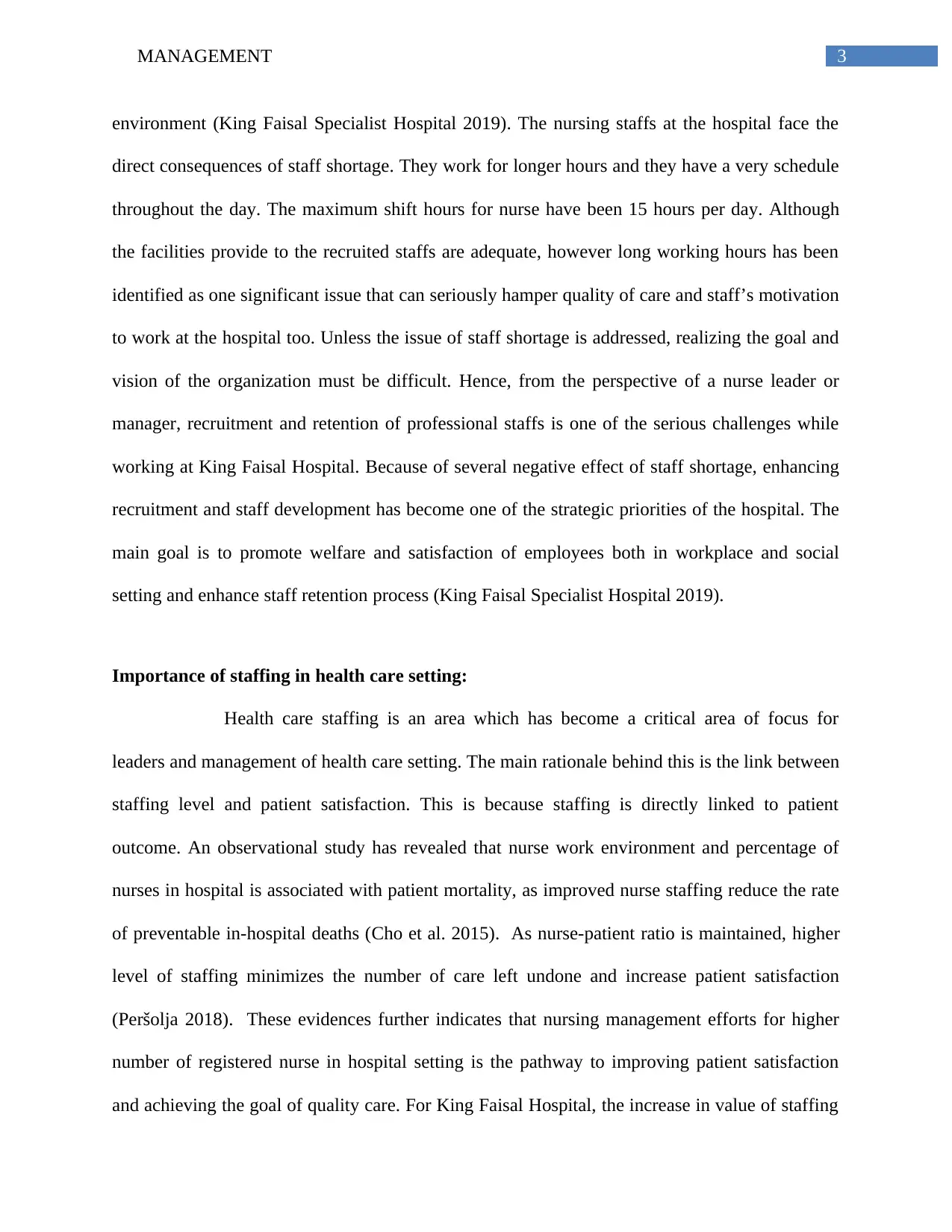
3MANAGEMENT
environment (King Faisal Specialist Hospital 2019). The nursing staffs at the hospital face the
direct consequences of staff shortage. They work for longer hours and they have a very schedule
throughout the day. The maximum shift hours for nurse have been 15 hours per day. Although
the facilities provide to the recruited staffs are adequate, however long working hours has been
identified as one significant issue that can seriously hamper quality of care and staff’s motivation
to work at the hospital too. Unless the issue of staff shortage is addressed, realizing the goal and
vision of the organization must be difficult. Hence, from the perspective of a nurse leader or
manager, recruitment and retention of professional staffs is one of the serious challenges while
working at King Faisal Hospital. Because of several negative effect of staff shortage, enhancing
recruitment and staff development has become one of the strategic priorities of the hospital. The
main goal is to promote welfare and satisfaction of employees both in workplace and social
setting and enhance staff retention process (King Faisal Specialist Hospital 2019).
Importance of staffing in health care setting:
Health care staffing is an area which has become a critical area of focus for
leaders and management of health care setting. The main rationale behind this is the link between
staffing level and patient satisfaction. This is because staffing is directly linked to patient
outcome. An observational study has revealed that nurse work environment and percentage of
nurses in hospital is associated with patient mortality, as improved nurse staffing reduce the rate
of preventable in-hospital deaths (Cho et al. 2015). As nurse-patient ratio is maintained, higher
level of staffing minimizes the number of care left undone and increase patient satisfaction
(Peršolja 2018). These evidences further indicates that nursing management efforts for higher
number of registered nurse in hospital setting is the pathway to improving patient satisfaction
and achieving the goal of quality care. For King Faisal Hospital, the increase in value of staffing
environment (King Faisal Specialist Hospital 2019). The nursing staffs at the hospital face the
direct consequences of staff shortage. They work for longer hours and they have a very schedule
throughout the day. The maximum shift hours for nurse have been 15 hours per day. Although
the facilities provide to the recruited staffs are adequate, however long working hours has been
identified as one significant issue that can seriously hamper quality of care and staff’s motivation
to work at the hospital too. Unless the issue of staff shortage is addressed, realizing the goal and
vision of the organization must be difficult. Hence, from the perspective of a nurse leader or
manager, recruitment and retention of professional staffs is one of the serious challenges while
working at King Faisal Hospital. Because of several negative effect of staff shortage, enhancing
recruitment and staff development has become one of the strategic priorities of the hospital. The
main goal is to promote welfare and satisfaction of employees both in workplace and social
setting and enhance staff retention process (King Faisal Specialist Hospital 2019).
Importance of staffing in health care setting:
Health care staffing is an area which has become a critical area of focus for
leaders and management of health care setting. The main rationale behind this is the link between
staffing level and patient satisfaction. This is because staffing is directly linked to patient
outcome. An observational study has revealed that nurse work environment and percentage of
nurses in hospital is associated with patient mortality, as improved nurse staffing reduce the rate
of preventable in-hospital deaths (Cho et al. 2015). As nurse-patient ratio is maintained, higher
level of staffing minimizes the number of care left undone and increase patient satisfaction
(Peršolja 2018). These evidences further indicates that nursing management efforts for higher
number of registered nurse in hospital setting is the pathway to improving patient satisfaction
and achieving the goal of quality care. For King Faisal Hospital, the increase in value of staffing
Paraphrase This Document
Need a fresh take? Get an instant paraphrase of this document with our AI Paraphraser
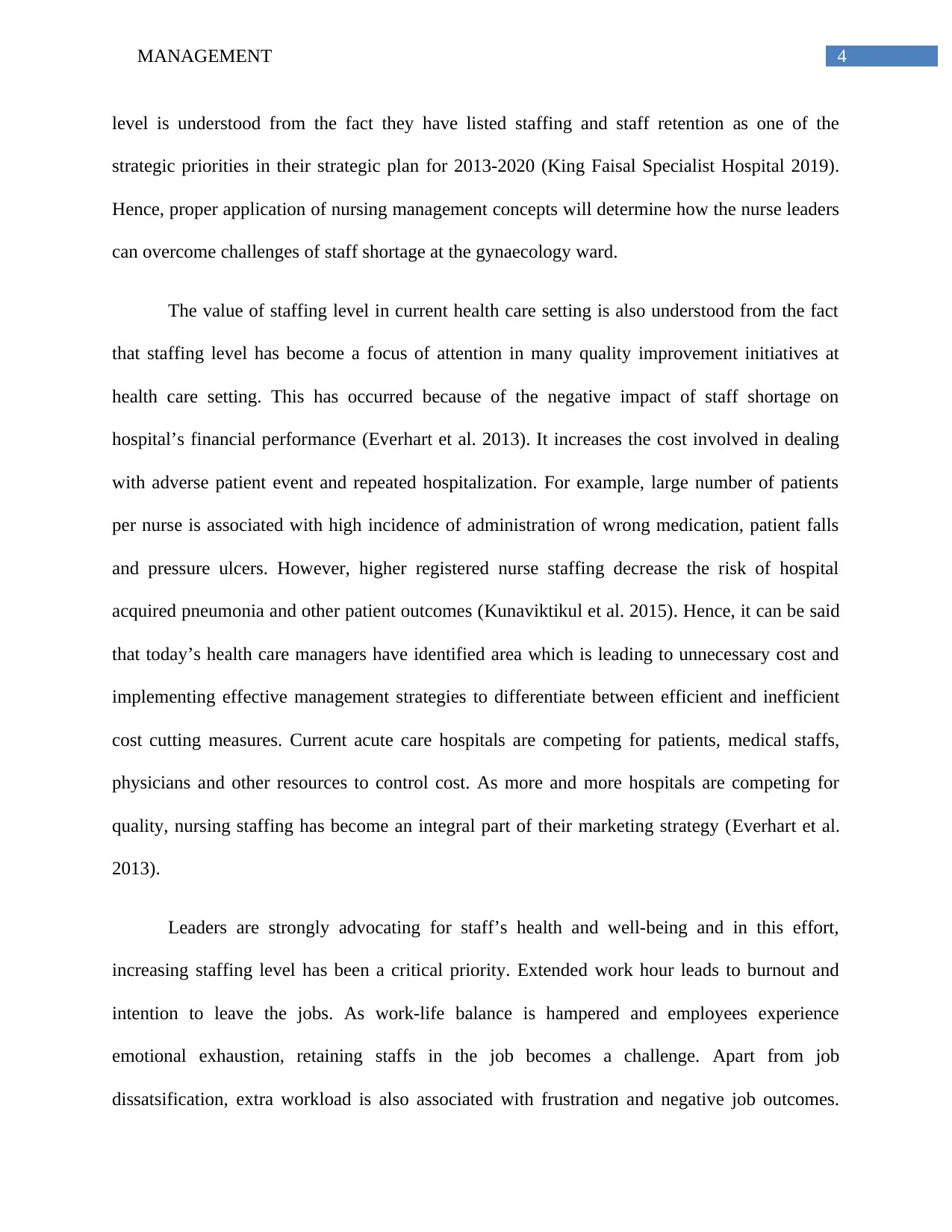
4MANAGEMENT
level is understood from the fact they have listed staffing and staff retention as one of the
strategic priorities in their strategic plan for 2013-2020 (King Faisal Specialist Hospital 2019).
Hence, proper application of nursing management concepts will determine how the nurse leaders
can overcome challenges of staff shortage at the gynaecology ward.
The value of staffing level in current health care setting is also understood from the fact
that staffing level has become a focus of attention in many quality improvement initiatives at
health care setting. This has occurred because of the negative impact of staff shortage on
hospital’s financial performance (Everhart et al. 2013). It increases the cost involved in dealing
with adverse patient event and repeated hospitalization. For example, large number of patients
per nurse is associated with high incidence of administration of wrong medication, patient falls
and pressure ulcers. However, higher registered nurse staffing decrease the risk of hospital
acquired pneumonia and other patient outcomes (Kunaviktikul et al. 2015). Hence, it can be said
that today’s health care managers have identified area which is leading to unnecessary cost and
implementing effective management strategies to differentiate between efficient and inefficient
cost cutting measures. Current acute care hospitals are competing for patients, medical staffs,
physicians and other resources to control cost. As more and more hospitals are competing for
quality, nursing staffing has become an integral part of their marketing strategy (Everhart et al.
2013).
Leaders are strongly advocating for staff’s health and well-being and in this effort,
increasing staffing level has been a critical priority. Extended work hour leads to burnout and
intention to leave the jobs. As work-life balance is hampered and employees experience
emotional exhaustion, retaining staffs in the job becomes a challenge. Apart from job
dissatsification, extra workload is also associated with frustration and negative job outcomes.
level is understood from the fact they have listed staffing and staff retention as one of the
strategic priorities in their strategic plan for 2013-2020 (King Faisal Specialist Hospital 2019).
Hence, proper application of nursing management concepts will determine how the nurse leaders
can overcome challenges of staff shortage at the gynaecology ward.
The value of staffing level in current health care setting is also understood from the fact
that staffing level has become a focus of attention in many quality improvement initiatives at
health care setting. This has occurred because of the negative impact of staff shortage on
hospital’s financial performance (Everhart et al. 2013). It increases the cost involved in dealing
with adverse patient event and repeated hospitalization. For example, large number of patients
per nurse is associated with high incidence of administration of wrong medication, patient falls
and pressure ulcers. However, higher registered nurse staffing decrease the risk of hospital
acquired pneumonia and other patient outcomes (Kunaviktikul et al. 2015). Hence, it can be said
that today’s health care managers have identified area which is leading to unnecessary cost and
implementing effective management strategies to differentiate between efficient and inefficient
cost cutting measures. Current acute care hospitals are competing for patients, medical staffs,
physicians and other resources to control cost. As more and more hospitals are competing for
quality, nursing staffing has become an integral part of their marketing strategy (Everhart et al.
2013).
Leaders are strongly advocating for staff’s health and well-being and in this effort,
increasing staffing level has been a critical priority. Extended work hour leads to burnout and
intention to leave the jobs. As work-life balance is hampered and employees experience
emotional exhaustion, retaining staffs in the job becomes a challenge. Apart from job
dissatsification, extra workload is also associated with frustration and negative job outcomes.
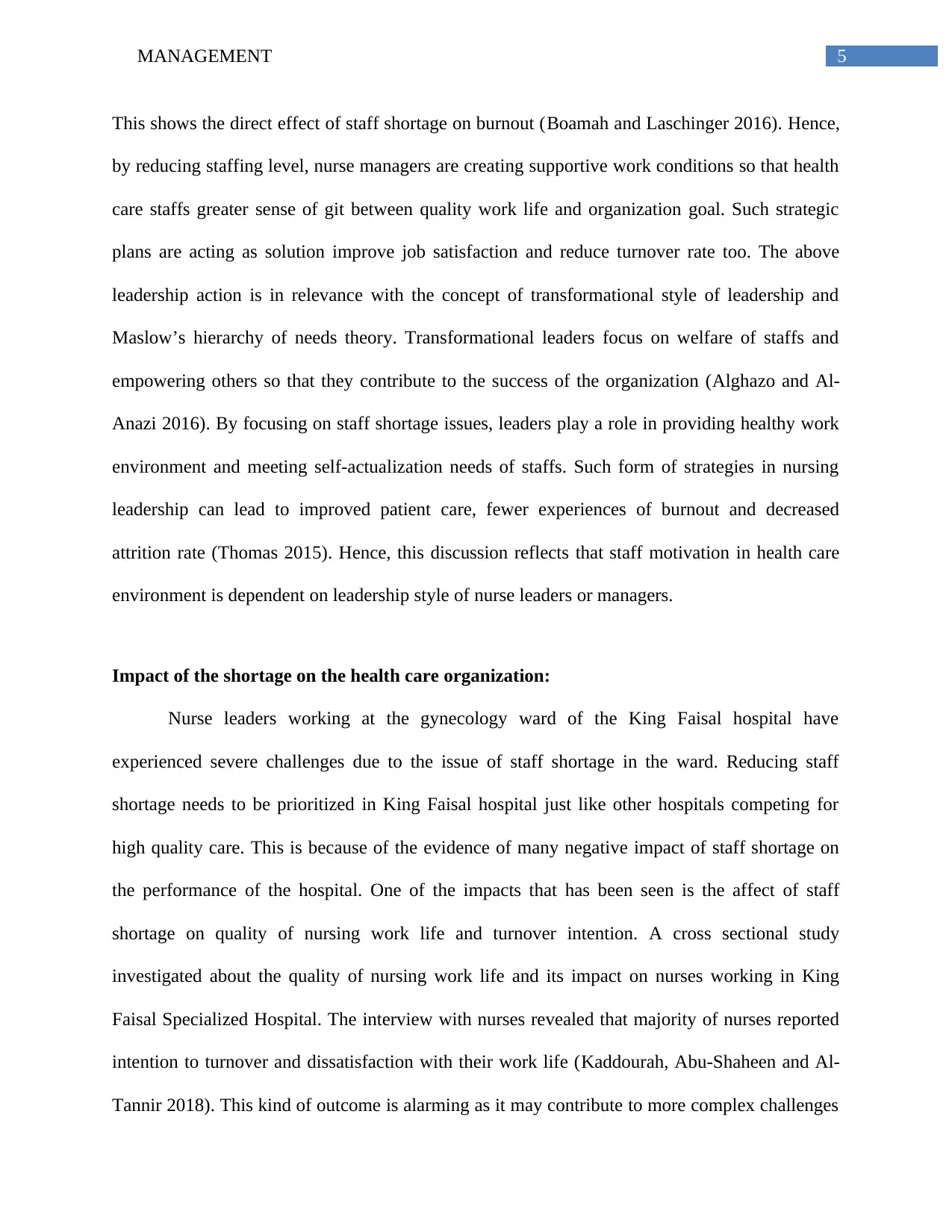
5MANAGEMENT
This shows the direct effect of staff shortage on burnout (Boamah and Laschinger 2016). Hence,
by reducing staffing level, nurse managers are creating supportive work conditions so that health
care staffs greater sense of git between quality work life and organization goal. Such strategic
plans are acting as solution improve job satisfaction and reduce turnover rate too. The above
leadership action is in relevance with the concept of transformational style of leadership and
Maslow’s hierarchy of needs theory. Transformational leaders focus on welfare of staffs and
empowering others so that they contribute to the success of the organization (Alghazo and Al-
Anazi 2016). By focusing on staff shortage issues, leaders play a role in providing healthy work
environment and meeting self-actualization needs of staffs. Such form of strategies in nursing
leadership can lead to improved patient care, fewer experiences of burnout and decreased
attrition rate (Thomas 2015). Hence, this discussion reflects that staff motivation in health care
environment is dependent on leadership style of nurse leaders or managers.
Impact of the shortage on the health care organization:
Nurse leaders working at the gynecology ward of the King Faisal hospital have
experienced severe challenges due to the issue of staff shortage in the ward. Reducing staff
shortage needs to be prioritized in King Faisal hospital just like other hospitals competing for
high quality care. This is because of the evidence of many negative impact of staff shortage on
the performance of the hospital. One of the impacts that has been seen is the affect of staff
shortage on quality of nursing work life and turnover intention. A cross sectional study
investigated about the quality of nursing work life and its impact on nurses working in King
Faisal Specialized Hospital. The interview with nurses revealed that majority of nurses reported
intention to turnover and dissatisfaction with their work life (Kaddourah, Abu-Shaheen and Al-
Tannir 2018). This kind of outcome is alarming as it may contribute to more complex challenges
This shows the direct effect of staff shortage on burnout (Boamah and Laschinger 2016). Hence,
by reducing staffing level, nurse managers are creating supportive work conditions so that health
care staffs greater sense of git between quality work life and organization goal. Such strategic
plans are acting as solution improve job satisfaction and reduce turnover rate too. The above
leadership action is in relevance with the concept of transformational style of leadership and
Maslow’s hierarchy of needs theory. Transformational leaders focus on welfare of staffs and
empowering others so that they contribute to the success of the organization (Alghazo and Al-
Anazi 2016). By focusing on staff shortage issues, leaders play a role in providing healthy work
environment and meeting self-actualization needs of staffs. Such form of strategies in nursing
leadership can lead to improved patient care, fewer experiences of burnout and decreased
attrition rate (Thomas 2015). Hence, this discussion reflects that staff motivation in health care
environment is dependent on leadership style of nurse leaders or managers.
Impact of the shortage on the health care organization:
Nurse leaders working at the gynecology ward of the King Faisal hospital have
experienced severe challenges due to the issue of staff shortage in the ward. Reducing staff
shortage needs to be prioritized in King Faisal hospital just like other hospitals competing for
high quality care. This is because of the evidence of many negative impact of staff shortage on
the performance of the hospital. One of the impacts that has been seen is the affect of staff
shortage on quality of nursing work life and turnover intention. A cross sectional study
investigated about the quality of nursing work life and its impact on nurses working in King
Faisal Specialized Hospital. The interview with nurses revealed that majority of nurses reported
intention to turnover and dissatisfaction with their work life (Kaddourah, Abu-Shaheen and Al-
Tannir 2018). This kind of outcome is alarming as it may contribute to more complex challenges
⊘ This is a preview!⊘
Do you want full access?
Subscribe today to unlock all pages.

Trusted by 1+ million students worldwide
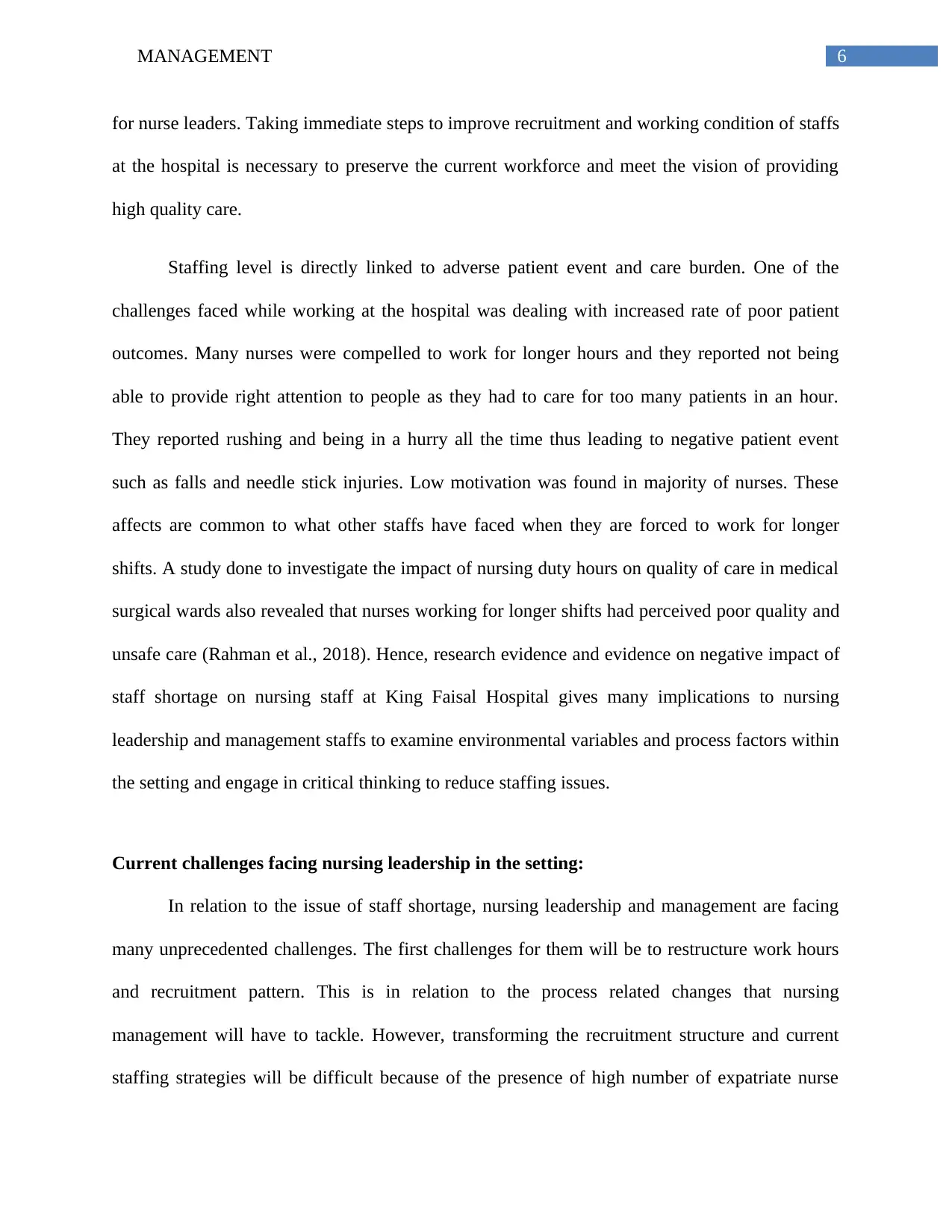
6MANAGEMENT
for nurse leaders. Taking immediate steps to improve recruitment and working condition of staffs
at the hospital is necessary to preserve the current workforce and meet the vision of providing
high quality care.
Staffing level is directly linked to adverse patient event and care burden. One of the
challenges faced while working at the hospital was dealing with increased rate of poor patient
outcomes. Many nurses were compelled to work for longer hours and they reported not being
able to provide right attention to people as they had to care for too many patients in an hour.
They reported rushing and being in a hurry all the time thus leading to negative patient event
such as falls and needle stick injuries. Low motivation was found in majority of nurses. These
affects are common to what other staffs have faced when they are forced to work for longer
shifts. A study done to investigate the impact of nursing duty hours on quality of care in medical
surgical wards also revealed that nurses working for longer shifts had perceived poor quality and
unsafe care (Rahman et al., 2018). Hence, research evidence and evidence on negative impact of
staff shortage on nursing staff at King Faisal Hospital gives many implications to nursing
leadership and management staffs to examine environmental variables and process factors within
the setting and engage in critical thinking to reduce staffing issues.
Current challenges facing nursing leadership in the setting:
In relation to the issue of staff shortage, nursing leadership and management are facing
many unprecedented challenges. The first challenges for them will be to restructure work hours
and recruitment pattern. This is in relation to the process related changes that nursing
management will have to tackle. However, transforming the recruitment structure and current
staffing strategies will be difficult because of the presence of high number of expatriate nurse
for nurse leaders. Taking immediate steps to improve recruitment and working condition of staffs
at the hospital is necessary to preserve the current workforce and meet the vision of providing
high quality care.
Staffing level is directly linked to adverse patient event and care burden. One of the
challenges faced while working at the hospital was dealing with increased rate of poor patient
outcomes. Many nurses were compelled to work for longer hours and they reported not being
able to provide right attention to people as they had to care for too many patients in an hour.
They reported rushing and being in a hurry all the time thus leading to negative patient event
such as falls and needle stick injuries. Low motivation was found in majority of nurses. These
affects are common to what other staffs have faced when they are forced to work for longer
shifts. A study done to investigate the impact of nursing duty hours on quality of care in medical
surgical wards also revealed that nurses working for longer shifts had perceived poor quality and
unsafe care (Rahman et al., 2018). Hence, research evidence and evidence on negative impact of
staff shortage on nursing staff at King Faisal Hospital gives many implications to nursing
leadership and management staffs to examine environmental variables and process factors within
the setting and engage in critical thinking to reduce staffing issues.
Current challenges facing nursing leadership in the setting:
In relation to the issue of staff shortage, nursing leadership and management are facing
many unprecedented challenges. The first challenges for them will be to restructure work hours
and recruitment pattern. This is in relation to the process related changes that nursing
management will have to tackle. However, transforming the recruitment structure and current
staffing strategies will be difficult because of the presence of high number of expatriate nurse
Paraphrase This Document
Need a fresh take? Get an instant paraphrase of this document with our AI Paraphraser
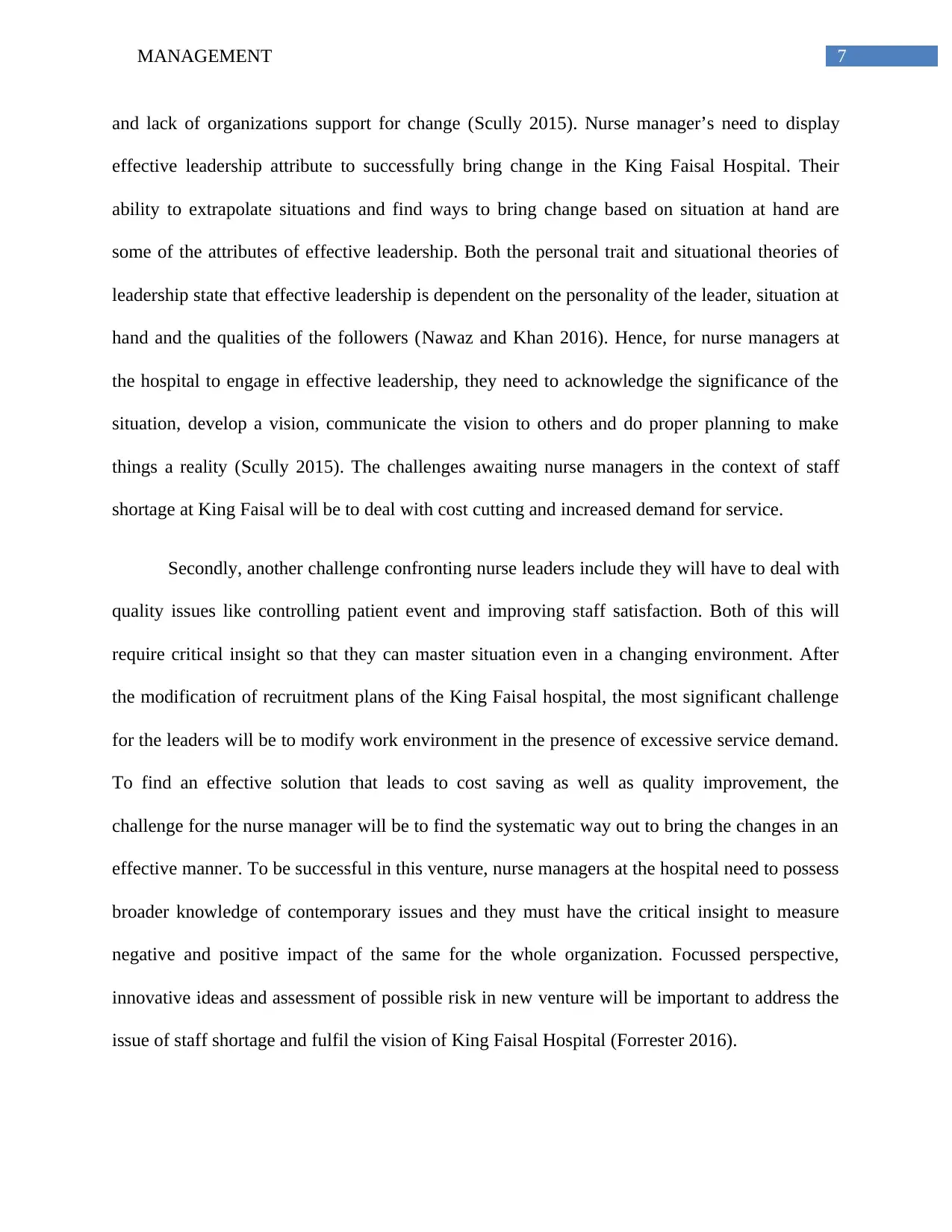
7MANAGEMENT
and lack of organizations support for change (Scully 2015). Nurse manager’s need to display
effective leadership attribute to successfully bring change in the King Faisal Hospital. Their
ability to extrapolate situations and find ways to bring change based on situation at hand are
some of the attributes of effective leadership. Both the personal trait and situational theories of
leadership state that effective leadership is dependent on the personality of the leader, situation at
hand and the qualities of the followers (Nawaz and Khan 2016). Hence, for nurse managers at
the hospital to engage in effective leadership, they need to acknowledge the significance of the
situation, develop a vision, communicate the vision to others and do proper planning to make
things a reality (Scully 2015). The challenges awaiting nurse managers in the context of staff
shortage at King Faisal will be to deal with cost cutting and increased demand for service.
Secondly, another challenge confronting nurse leaders include they will have to deal with
quality issues like controlling patient event and improving staff satisfaction. Both of this will
require critical insight so that they can master situation even in a changing environment. After
the modification of recruitment plans of the King Faisal hospital, the most significant challenge
for the leaders will be to modify work environment in the presence of excessive service demand.
To find an effective solution that leads to cost saving as well as quality improvement, the
challenge for the nurse manager will be to find the systematic way out to bring the changes in an
effective manner. To be successful in this venture, nurse managers at the hospital need to possess
broader knowledge of contemporary issues and they must have the critical insight to measure
negative and positive impact of the same for the whole organization. Focussed perspective,
innovative ideas and assessment of possible risk in new venture will be important to address the
issue of staff shortage and fulfil the vision of King Faisal Hospital (Forrester 2016).
and lack of organizations support for change (Scully 2015). Nurse manager’s need to display
effective leadership attribute to successfully bring change in the King Faisal Hospital. Their
ability to extrapolate situations and find ways to bring change based on situation at hand are
some of the attributes of effective leadership. Both the personal trait and situational theories of
leadership state that effective leadership is dependent on the personality of the leader, situation at
hand and the qualities of the followers (Nawaz and Khan 2016). Hence, for nurse managers at
the hospital to engage in effective leadership, they need to acknowledge the significance of the
situation, develop a vision, communicate the vision to others and do proper planning to make
things a reality (Scully 2015). The challenges awaiting nurse managers in the context of staff
shortage at King Faisal will be to deal with cost cutting and increased demand for service.
Secondly, another challenge confronting nurse leaders include they will have to deal with
quality issues like controlling patient event and improving staff satisfaction. Both of this will
require critical insight so that they can master situation even in a changing environment. After
the modification of recruitment plans of the King Faisal hospital, the most significant challenge
for the leaders will be to modify work environment in the presence of excessive service demand.
To find an effective solution that leads to cost saving as well as quality improvement, the
challenge for the nurse manager will be to find the systematic way out to bring the changes in an
effective manner. To be successful in this venture, nurse managers at the hospital need to possess
broader knowledge of contemporary issues and they must have the critical insight to measure
negative and positive impact of the same for the whole organization. Focussed perspective,
innovative ideas and assessment of possible risk in new venture will be important to address the
issue of staff shortage and fulfil the vision of King Faisal Hospital (Forrester 2016).
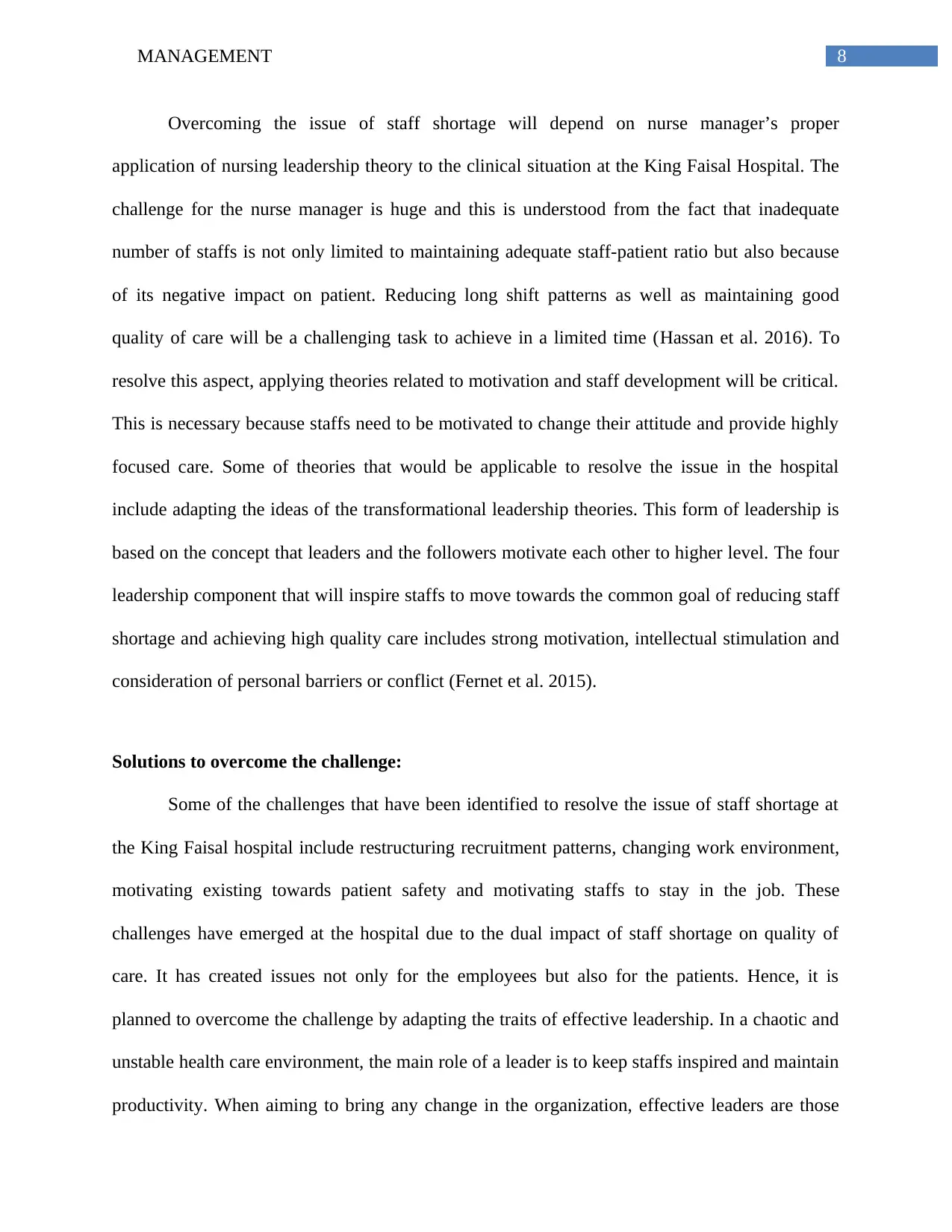
8MANAGEMENT
Overcoming the issue of staff shortage will depend on nurse manager’s proper
application of nursing leadership theory to the clinical situation at the King Faisal Hospital. The
challenge for the nurse manager is huge and this is understood from the fact that inadequate
number of staffs is not only limited to maintaining adequate staff-patient ratio but also because
of its negative impact on patient. Reducing long shift patterns as well as maintaining good
quality of care will be a challenging task to achieve in a limited time (Hassan et al. 2016). To
resolve this aspect, applying theories related to motivation and staff development will be critical.
This is necessary because staffs need to be motivated to change their attitude and provide highly
focused care. Some of theories that would be applicable to resolve the issue in the hospital
include adapting the ideas of the transformational leadership theories. This form of leadership is
based on the concept that leaders and the followers motivate each other to higher level. The four
leadership component that will inspire staffs to move towards the common goal of reducing staff
shortage and achieving high quality care includes strong motivation, intellectual stimulation and
consideration of personal barriers or conflict (Fernet et al. 2015).
Solutions to overcome the challenge:
Some of the challenges that have been identified to resolve the issue of staff shortage at
the King Faisal hospital include restructuring recruitment patterns, changing work environment,
motivating existing towards patient safety and motivating staffs to stay in the job. These
challenges have emerged at the hospital due to the dual impact of staff shortage on quality of
care. It has created issues not only for the employees but also for the patients. Hence, it is
planned to overcome the challenge by adapting the traits of effective leadership. In a chaotic and
unstable health care environment, the main role of a leader is to keep staffs inspired and maintain
productivity. When aiming to bring any change in the organization, effective leaders are those
Overcoming the issue of staff shortage will depend on nurse manager’s proper
application of nursing leadership theory to the clinical situation at the King Faisal Hospital. The
challenge for the nurse manager is huge and this is understood from the fact that inadequate
number of staffs is not only limited to maintaining adequate staff-patient ratio but also because
of its negative impact on patient. Reducing long shift patterns as well as maintaining good
quality of care will be a challenging task to achieve in a limited time (Hassan et al. 2016). To
resolve this aspect, applying theories related to motivation and staff development will be critical.
This is necessary because staffs need to be motivated to change their attitude and provide highly
focused care. Some of theories that would be applicable to resolve the issue in the hospital
include adapting the ideas of the transformational leadership theories. This form of leadership is
based on the concept that leaders and the followers motivate each other to higher level. The four
leadership component that will inspire staffs to move towards the common goal of reducing staff
shortage and achieving high quality care includes strong motivation, intellectual stimulation and
consideration of personal barriers or conflict (Fernet et al. 2015).
Solutions to overcome the challenge:
Some of the challenges that have been identified to resolve the issue of staff shortage at
the King Faisal hospital include restructuring recruitment patterns, changing work environment,
motivating existing towards patient safety and motivating staffs to stay in the job. These
challenges have emerged at the hospital due to the dual impact of staff shortage on quality of
care. It has created issues not only for the employees but also for the patients. Hence, it is
planned to overcome the challenge by adapting the traits of effective leadership. In a chaotic and
unstable health care environment, the main role of a leader is to keep staffs inspired and maintain
productivity. When aiming to bring any change in the organization, effective leaders are those
⊘ This is a preview!⊘
Do you want full access?
Subscribe today to unlock all pages.

Trusted by 1+ million students worldwide
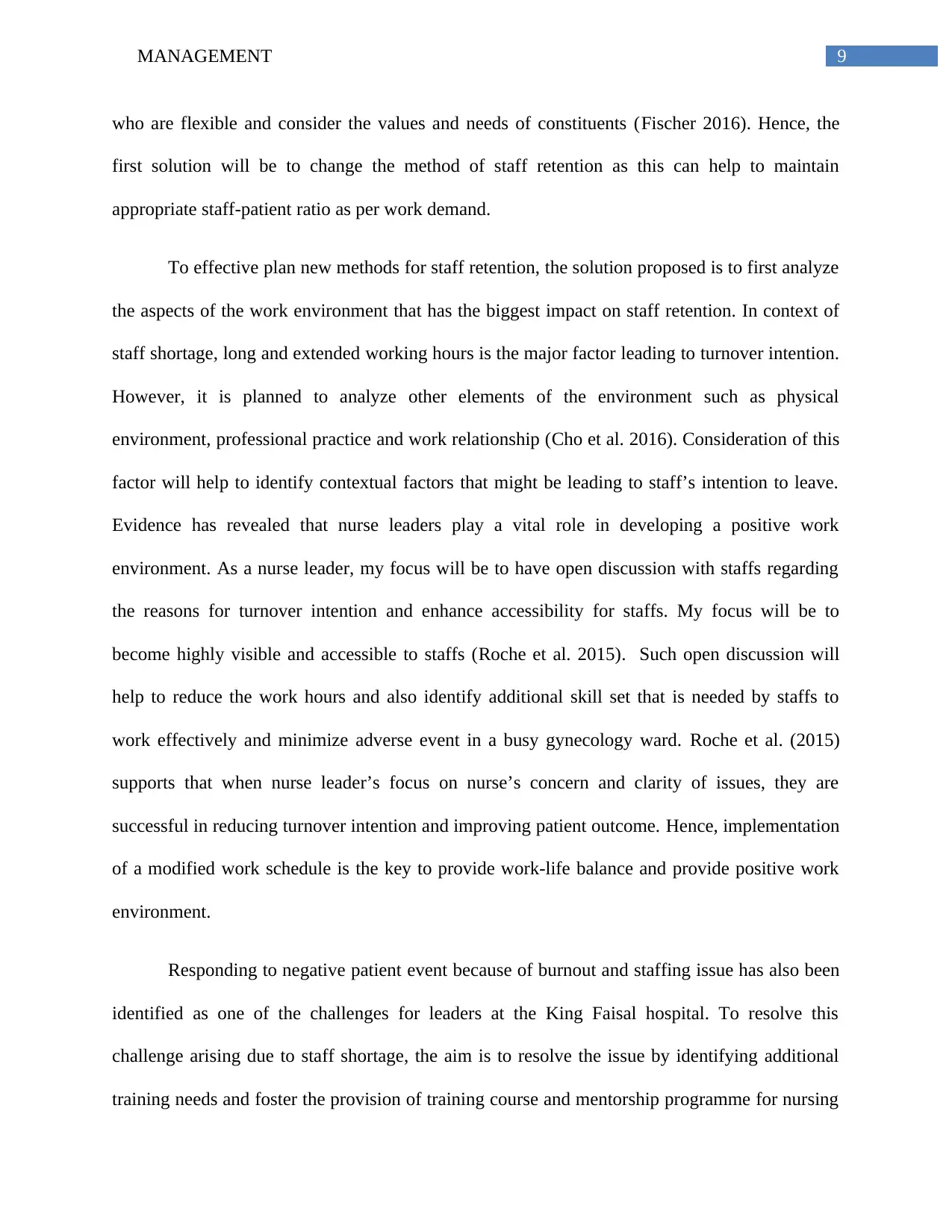
9MANAGEMENT
who are flexible and consider the values and needs of constituents (Fischer 2016). Hence, the
first solution will be to change the method of staff retention as this can help to maintain
appropriate staff-patient ratio as per work demand.
To effective plan new methods for staff retention, the solution proposed is to first analyze
the aspects of the work environment that has the biggest impact on staff retention. In context of
staff shortage, long and extended working hours is the major factor leading to turnover intention.
However, it is planned to analyze other elements of the environment such as physical
environment, professional practice and work relationship (Cho et al. 2016). Consideration of this
factor will help to identify contextual factors that might be leading to staff’s intention to leave.
Evidence has revealed that nurse leaders play a vital role in developing a positive work
environment. As a nurse leader, my focus will be to have open discussion with staffs regarding
the reasons for turnover intention and enhance accessibility for staffs. My focus will be to
become highly visible and accessible to staffs (Roche et al. 2015). Such open discussion will
help to reduce the work hours and also identify additional skill set that is needed by staffs to
work effectively and minimize adverse event in a busy gynecology ward. Roche et al. (2015)
supports that when nurse leader’s focus on nurse’s concern and clarity of issues, they are
successful in reducing turnover intention and improving patient outcome. Hence, implementation
of a modified work schedule is the key to provide work-life balance and provide positive work
environment.
Responding to negative patient event because of burnout and staffing issue has also been
identified as one of the challenges for leaders at the King Faisal hospital. To resolve this
challenge arising due to staff shortage, the aim is to resolve the issue by identifying additional
training needs and foster the provision of training course and mentorship programme for nursing
who are flexible and consider the values and needs of constituents (Fischer 2016). Hence, the
first solution will be to change the method of staff retention as this can help to maintain
appropriate staff-patient ratio as per work demand.
To effective plan new methods for staff retention, the solution proposed is to first analyze
the aspects of the work environment that has the biggest impact on staff retention. In context of
staff shortage, long and extended working hours is the major factor leading to turnover intention.
However, it is planned to analyze other elements of the environment such as physical
environment, professional practice and work relationship (Cho et al. 2016). Consideration of this
factor will help to identify contextual factors that might be leading to staff’s intention to leave.
Evidence has revealed that nurse leaders play a vital role in developing a positive work
environment. As a nurse leader, my focus will be to have open discussion with staffs regarding
the reasons for turnover intention and enhance accessibility for staffs. My focus will be to
become highly visible and accessible to staffs (Roche et al. 2015). Such open discussion will
help to reduce the work hours and also identify additional skill set that is needed by staffs to
work effectively and minimize adverse event in a busy gynecology ward. Roche et al. (2015)
supports that when nurse leader’s focus on nurse’s concern and clarity of issues, they are
successful in reducing turnover intention and improving patient outcome. Hence, implementation
of a modified work schedule is the key to provide work-life balance and provide positive work
environment.
Responding to negative patient event because of burnout and staffing issue has also been
identified as one of the challenges for leaders at the King Faisal hospital. To resolve this
challenge arising due to staff shortage, the aim is to resolve the issue by identifying additional
training needs and foster the provision of training course and mentorship programme for nursing
Paraphrase This Document
Need a fresh take? Get an instant paraphrase of this document with our AI Paraphraser
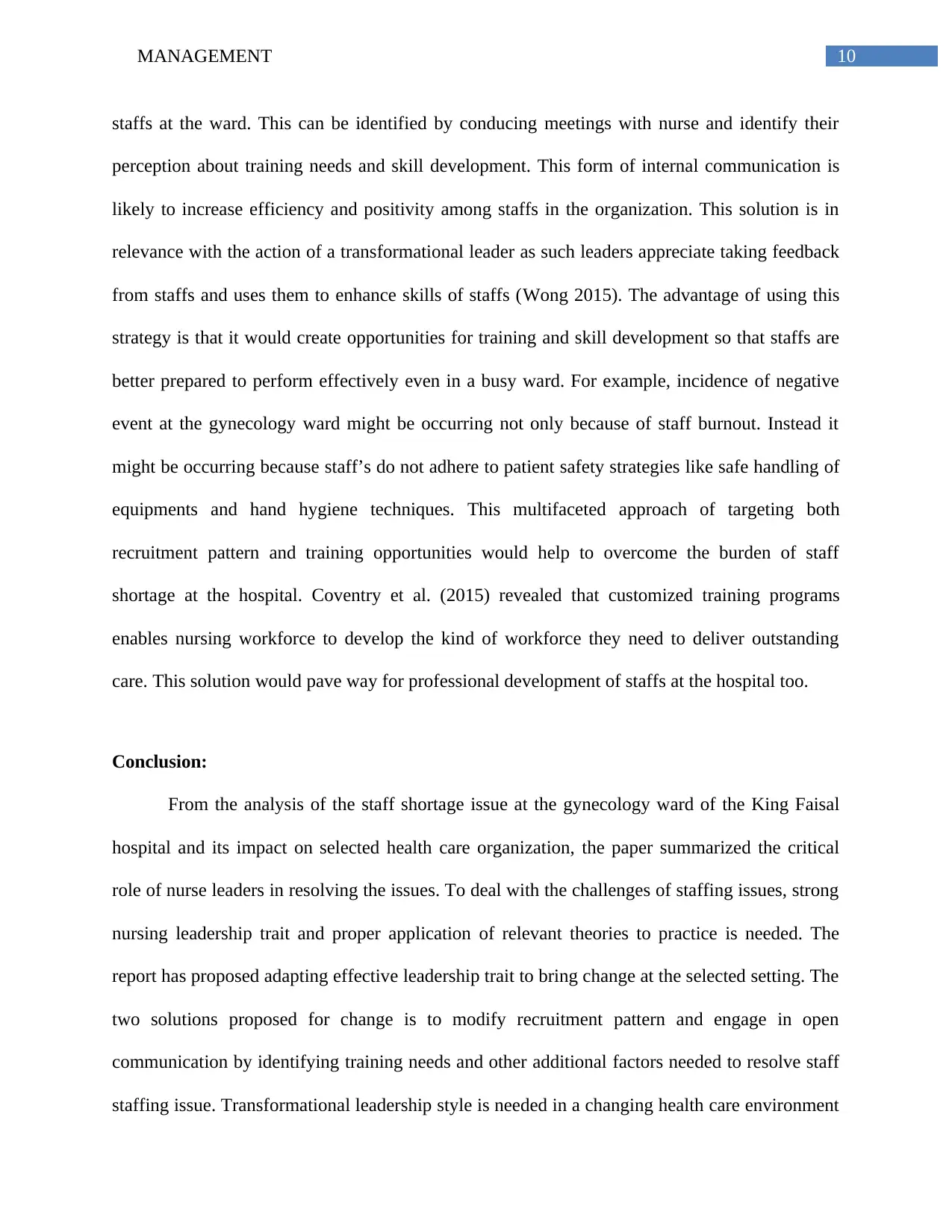
10MANAGEMENT
staffs at the ward. This can be identified by conducing meetings with nurse and identify their
perception about training needs and skill development. This form of internal communication is
likely to increase efficiency and positivity among staffs in the organization. This solution is in
relevance with the action of a transformational leader as such leaders appreciate taking feedback
from staffs and uses them to enhance skills of staffs (Wong 2015). The advantage of using this
strategy is that it would create opportunities for training and skill development so that staffs are
better prepared to perform effectively even in a busy ward. For example, incidence of negative
event at the gynecology ward might be occurring not only because of staff burnout. Instead it
might be occurring because staff’s do not adhere to patient safety strategies like safe handling of
equipments and hand hygiene techniques. This multifaceted approach of targeting both
recruitment pattern and training opportunities would help to overcome the burden of staff
shortage at the hospital. Coventry et al. (2015) revealed that customized training programs
enables nursing workforce to develop the kind of workforce they need to deliver outstanding
care. This solution would pave way for professional development of staffs at the hospital too.
Conclusion:
From the analysis of the staff shortage issue at the gynecology ward of the King Faisal
hospital and its impact on selected health care organization, the paper summarized the critical
role of nurse leaders in resolving the issues. To deal with the challenges of staffing issues, strong
nursing leadership trait and proper application of relevant theories to practice is needed. The
report has proposed adapting effective leadership trait to bring change at the selected setting. The
two solutions proposed for change is to modify recruitment pattern and engage in open
communication by identifying training needs and other additional factors needed to resolve staff
staffing issue. Transformational leadership style is needed in a changing health care environment
staffs at the ward. This can be identified by conducing meetings with nurse and identify their
perception about training needs and skill development. This form of internal communication is
likely to increase efficiency and positivity among staffs in the organization. This solution is in
relevance with the action of a transformational leader as such leaders appreciate taking feedback
from staffs and uses them to enhance skills of staffs (Wong 2015). The advantage of using this
strategy is that it would create opportunities for training and skill development so that staffs are
better prepared to perform effectively even in a busy ward. For example, incidence of negative
event at the gynecology ward might be occurring not only because of staff burnout. Instead it
might be occurring because staff’s do not adhere to patient safety strategies like safe handling of
equipments and hand hygiene techniques. This multifaceted approach of targeting both
recruitment pattern and training opportunities would help to overcome the burden of staff
shortage at the hospital. Coventry et al. (2015) revealed that customized training programs
enables nursing workforce to develop the kind of workforce they need to deliver outstanding
care. This solution would pave way for professional development of staffs at the hospital too.
Conclusion:
From the analysis of the staff shortage issue at the gynecology ward of the King Faisal
hospital and its impact on selected health care organization, the paper summarized the critical
role of nurse leaders in resolving the issues. To deal with the challenges of staffing issues, strong
nursing leadership trait and proper application of relevant theories to practice is needed. The
report has proposed adapting effective leadership trait to bring change at the selected setting. The
two solutions proposed for change is to modify recruitment pattern and engage in open
communication by identifying training needs and other additional factors needed to resolve staff
staffing issue. Transformational leadership style is needed in a changing health care environment
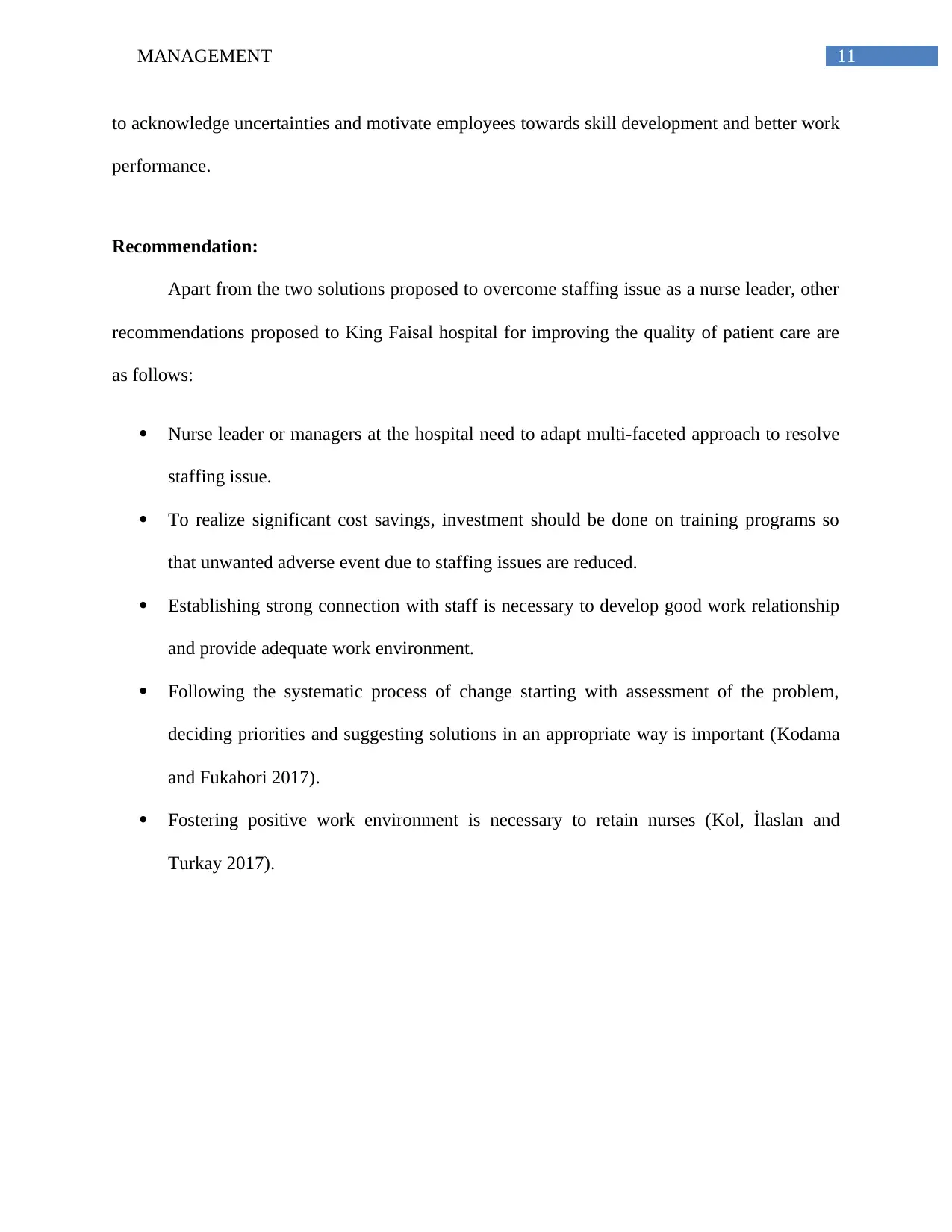
11MANAGEMENT
to acknowledge uncertainties and motivate employees towards skill development and better work
performance.
Recommendation:
Apart from the two solutions proposed to overcome staffing issue as a nurse leader, other
recommendations proposed to King Faisal hospital for improving the quality of patient care are
as follows:
Nurse leader or managers at the hospital need to adapt multi-faceted approach to resolve
staffing issue.
To realize significant cost savings, investment should be done on training programs so
that unwanted adverse event due to staffing issues are reduced.
Establishing strong connection with staff is necessary to develop good work relationship
and provide adequate work environment.
Following the systematic process of change starting with assessment of the problem,
deciding priorities and suggesting solutions in an appropriate way is important (Kodama
and Fukahori 2017).
Fostering positive work environment is necessary to retain nurses (Kol, İlaslan and
Turkay 2017).
to acknowledge uncertainties and motivate employees towards skill development and better work
performance.
Recommendation:
Apart from the two solutions proposed to overcome staffing issue as a nurse leader, other
recommendations proposed to King Faisal hospital for improving the quality of patient care are
as follows:
Nurse leader or managers at the hospital need to adapt multi-faceted approach to resolve
staffing issue.
To realize significant cost savings, investment should be done on training programs so
that unwanted adverse event due to staffing issues are reduced.
Establishing strong connection with staff is necessary to develop good work relationship
and provide adequate work environment.
Following the systematic process of change starting with assessment of the problem,
deciding priorities and suggesting solutions in an appropriate way is important (Kodama
and Fukahori 2017).
Fostering positive work environment is necessary to retain nurses (Kol, İlaslan and
Turkay 2017).
⊘ This is a preview!⊘
Do you want full access?
Subscribe today to unlock all pages.

Trusted by 1+ million students worldwide
1 out of 15
Related Documents
Your All-in-One AI-Powered Toolkit for Academic Success.
+13062052269
info@desklib.com
Available 24*7 on WhatsApp / Email
![[object Object]](/_next/static/media/star-bottom.7253800d.svg)
Unlock your academic potential
Copyright © 2020–2025 A2Z Services. All Rights Reserved. Developed and managed by ZUCOL.





